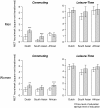The association of leisure-time physical activity and active commuting with measures of socioeconomic position in a multiethnic population living in the Netherlands: results from the cross-sectional SUNSET study
- PMID: 22998730
- PMCID: PMC3490879
- DOI: 10.1186/1471-2458-12-815
The association of leisure-time physical activity and active commuting with measures of socioeconomic position in a multiethnic population living in the Netherlands: results from the cross-sectional SUNSET study
Abstract
Background: In most European origin populations measures of socioeconomic position are positively associated with leisure time physical activity (LTPA), this is unclear for active commuting. In addition, these associations have scarcely been studied in ethnic minority groups, who often have a high cardiovascular disease risk. Because of the expected public health potential, we assessed the relationship of active commuting and LTPA with measures of socioeconomic position across two large ethnic minority groups in the Netherlands as compared to the European-Dutch population.
Methods: We included South Asian-Surinamese (n = 370), African-Surinamese (n = 689), and European-Dutch (n = 567) from the cross-sectional population-based SUNSET study (2001-2003). Active commuting and LTPA were assessed by the SQUASH physical activity questionnaire and calculated in square-root-transformed metabolic equivalents of task-hours/week (SQRTMET). Socioeconomic position was indicated by level of education (low/high) and occupational class (low/high). We used age-adjusted linear regression models to assess the association between physical activity and socioeconomic position.
Results: Compared to the European-Dutch men, South Asian-Surinamese men engaged in lower levels of commuting activity and LTPA, and South Asian-Surinamese women engaged in lower levels of LTPA than their European-Dutch counterparts. Differences between the African Surinamese and the European-Dutch were small. We observed a positive gradient in active commuting activity for education in European-Dutch men (beta high education was 0.93, 95%CI: 0.45-1.40 SQRTMET higher versus low education), in South Asian-Surinamese men (beta: 0.56, 0.19-0.92), but not in African-Surinamese men (-0.06, -0.45-0.33, p for ethnicity-interaction = 0.002). In women we observed a positive gradient in active commuting activity and occupational class in European-Dutch women, and less strongly in South Asian-Surinamese and African-Surinamese women (p for ethnicity-interaction = 0.02). For LTPA and socioeconomic position, we observed no statistically significant interaction by ethnicity.
Conclusions: The positive gradient for socioeconomic position observed in European-Dutch was less strong, in particular for active commuting, among the South Asian-Surinamese and the African-Surinamese. This indicates that the typical focus on physical activity interventions in lower socioeconomic groups could work for European-Dutch populations, but this strategy may not be entirely applicable in the ethnic minority groups.
Figures


Similar articles
-
Total physical activity might not be a good measure in the relationship with HDL cholesterol and triglycerides in a multi-ethnic population: a cross-sectional study.Lipids Health Dis. 2011 Nov 30;10:223. doi: 10.1186/1476-511X-10-223. Lipids Health Dis. 2011. PMID: 22128756 Free PMC article.
-
Acculturation and education level in relation to quality of the diet: a study of Surinamese South Asian and Afro-Caribbean residents of the Netherlands.J Hum Nutr Diet. 2006 Oct;19(5):383-93. doi: 10.1111/j.1365-277X.2006.00720.x. J Hum Nutr Diet. 2006. PMID: 16961685
-
Cross national study of leisure-time physical activity in Dutch and English populations with ethnic group comparisons.Eur J Public Health. 2013 Jun;23(3):440-6. doi: 10.1093/eurpub/cks088. Epub 2012 Jul 18. Eur J Public Health. 2013. PMID: 22809760
-
Prevalence and determinants of prehypertension among African Surinamese, Hindustani Surinamese, and White Dutch in Amsterdam, the Netherlands: the SUNSET study.Eur J Cardiovasc Prev Rehabil. 2007 Dec;14(6):775-81. doi: 10.1097/HJR.0b013e32828621df. Eur J Cardiovasc Prev Rehabil. 2007. PMID: 18043298
-
[Cardiovascular risk factors for Surinamese in the Netherlands: a literature review].Ned Tijdschr Geneeskd. 2003 Aug 16;147(33):1591-4. Ned Tijdschr Geneeskd. 2003. PMID: 12951729 Review. Dutch.
Cited by
-
The Role of Physical Activity Prescription in Cardiovascular Disease Prevention Amongst South Asian Canadians.Front Cardiovasc Med. 2018 Nov 14;5:165. doi: 10.3389/fcvm.2018.00165. eCollection 2018. Front Cardiovasc Med. 2018. PMID: 30488037 Free PMC article. Review.
-
Physical activity participation among Arab immigrants and refugees in Western societies: A scoping review.Prev Med Rep. 2021 Mar 26;22:101365. doi: 10.1016/j.pmedr.2021.101365. eCollection 2021 Jun. Prev Med Rep. 2021. PMID: 33868904 Free PMC article.
-
Physical Activity Status and Position of Governmental Employees in Changing Stage Based on the Trans-Theoretical Model in Hamadan, Iran.Glob J Health Sci. 2015 Feb 24;7(5):23-32. doi: 10.5539/gjhs.v7n5p23. Glob J Health Sci. 2015. PMID: 26156899 Free PMC article.
-
Health Beliefs regarding Dietary Behavior and Physical Activity of Surinamese Immigrants of Indian Descent in The Netherlands: A Qualitative Study.ISRN Obes. 2012 Nov 27;2012:903868. doi: 10.5402/2012/903868. eCollection 2012. ISRN Obes. 2012. PMID: 24533213 Free PMC article.
-
Socioeconomic Correlates and Determinants of Cardiorespiratory Fitness in the General Adult Population: a Systematic Review and Meta-Analysis.Sports Med Open. 2018 Jun 7;4(1):25. doi: 10.1186/s40798-018-0137-0. Sports Med Open. 2018. PMID: 29882063 Free PMC article. Review.
References
-
- Graham I, Atar D, Borch-Johnsen K, Boysen G, Burell G, Cifkova R. et al.European guidelines on cardiovascular disease prevention in clinical practice: full text. Fourth Joint Task Force of the European Society of Cardiology and other societies on cardiovascular disease prevention in clinical practice (constituted by representatives of nine societies and by invited experts) Eur J Cardiovasc Prev Rehabil. 2007;14(2):1–113. - PubMed
-
- Cochrane T, Davey RC, Gidlow C, Smith GR, Fairburn J, Armitage CJ. et al.Small area and individual level predictors of physical activity in urban communities: a multi-level study in Stoke on Trent, England. Int J Environ Res Public Health. 2009;6:654–677. doi: 10.3390/ijerph6020654. - DOI - PMC - PubMed
Publication types
MeSH terms
LinkOut - more resources
Full Text Sources

